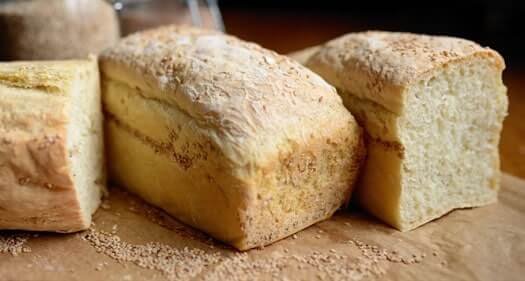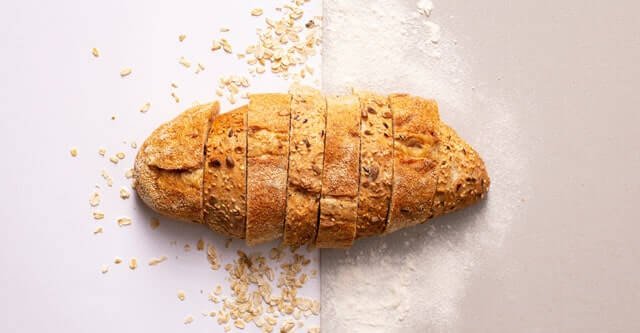Last Updated on January 31, 2021 by Dr Sharon Baisil MD
Food is a basic necessity for us, but what is not so basic is the perfect selection. To always keep our bodies protected, fit, and healthy, we have to pay attention to every little detail.
Such points also have to be kept in mind even when it comes to the most basic food items. Special care needs to be taken if you are a diabetic patient.
Today, we are talking about one such very common food item that is almost an inclusion for our everyday meals. We are talking about – Bread.
You might be wondering …
- Is bread safe for diabetics?
- How many slices of bread can a diabetic have per day?
- What are the nutritional elements found in bread?
- What are some healthy bread alternatives?
Well, we are here for you. We will provide you with all the answers. So without wasting any more time, let us find out!
Is Bread Safe for Diabetics?

Diabetes is a condition of the body’s metabolism and hormones. Many foods can cause a fluctuation in blood sugar levels, which can have a diabetic effect on the body. Therefore, one has to be extra careful about what one eats as a diabetic.
When it comes to bread, the answer to your question depends on the type of bread you consume.
White bread, which is made from refined white flour is not a recommended bread type for diabetes. It can lead to higher levels of blood sugar as white bread is high in carbohydrates. This, in turn, can harm the body’s metabolism, insulin functioning, and overall system.
White bread is among the starchy food category that increases the risks of developing or worsening diabetic health.
The refining of the flour used in making the white bread is stripped of its good nutrients and left with a lot of carbohydrates. This increases the overall sugar content in the body when consumed.
White bread is harmful upon daily consumption. Even fewer amounts of it can lead to an imbalance in the body’s diabetic levels leading to health problems.
Hence, it is very better and important to know about better alternatives to this daily staple food item.
Controlling the portions of foods that you decide to add to the diet also makes it healthier and safer for your health. We will tell you about the right bread portions later in this article.
Besides even though the metabolic and insulin reaction of every individual differs from each other. Still, the general observation about bread is that it will increase the sugar levels among all individuals.
Hence, it is essential to know the best substitutes. We will tell you about the better bread options that you can go to.
What is the Glycemic Index of bread?

The Glycemic Index is an accurate indicator of the effects of food on blood sugar levels. It depicts this based on the carbohydrate found in the food.
Glycemic Index is measure on a scale from 0 to 100. Foods are then categorized into the following three categories:
| Sl. No. | Glycemic Index categories | Glycemic Index ranges |
| 1. | Low Glycemic Index (safe for diabetics) | 0 to 55 |
| 2. | Medium Glycemic Index (safe if taken in controlled quantities) | 55 to 69 |
| 3. | High Glycemic Index (unsafe for diabetics) | From 70 and above |
Wondering what the Glycemic Index of white bread is? Well, unfortunately, it is not on the safer side.
The Glycemic Index of White bread is over 75. This crosses the High Glycemic Index range and can give rise to spikes in blood glucose levels.
This, even low quantities of white bread, can be unsafe for diabetics. But, let us find out the limit for this bread, based on one’s diabetic health.
How many slices of bread can a diabetic have per day?

According to a regular person’s calorie intakes, one can have around three medium slices of refined white flour bread in a day.
When it comes to a diabetic patient, this number changes, it is best not to consume white flour bread, but if doing so, make sure not to go over two medium slices.
One slice of bread can provide around 32 calories. For a diabetes patient, the total calories obtained from brad must not cross 90.
Moreover, it is inadvisable to have white bread every day for diabetics. It may lead to further complications in your blood sugar levels.
Nutritional Composition of white bread

The table below shows the several nutrients found in bread and their respective quantities.
| Sl. No. | Nutrients found in 100 g of white bread | Amounts available |
| 1. | Calories | 313 |
| 2. | Carbohydrates – Dietary fiber – Total sugar | 56 g – 5 g – 6 g |
| 3. | Fat | 4.27 g |
| 4. | Protein | 12.96 g |
| 5. | Water | 24.23 g |
| 6. | Choline | 22.1 mg |
| 7. | Potassium | 223 mg |
| 8. | Zinc | 1.47 mg |
| 9. | Phosphorus | 188 mg |
| 10. | Copper | 0.198 mg |
| 11. | Manganese | 1.377 mg |
| 12. | Selenium | 33.4 mg |
| 13. | Magnesium | 59 mg |
| 14. | Sodium | 601 mg |
| 15. | Calcium | 165 mg |
| 16. | Iron | 4.09 mg |
| 17. | Folic acid | 20 µg |
| 18. | Vitamin B3 | 6.25 µg |
| 19. | Vitamin B2 | 0.382 µg |
| 20. | Vitamin E | 0.24 µg |
| 21. | Vitamin B5 | 0.456 µg |
| 22. | Vitamin B6 | 0.153 µg |
| 23. | Vitamin K | 5.7 µg |
| 24. | Vitamin C | 0.2 µg |
| 25. | Folate | 86 µg |
| 26. | Vitamin B1 | 0.439 µg |
What breads are safe for diabetics?

Until now, we discussed that white refined flour bread is not the greatest choice for bread when it comes to a diabetic meal. But what is a good bread option then? What are some types of bread that can be used as an alternative to white bread?
Below listed are some safe and healthy bread options for diabetic patients:
Whole wheat bread

Whole wheat grain bread is a better choice over polished or refined wheat bread. The processes of refining the grains take off all the healthy fibers and nutrients present in the grains.
100% whole wheat bread is good over white flour bread. It is safe for diabetics and contains lesser harmful carbs and calories.
Unlike white bread, whole-grain wheat bread does not have added sugars either. This is proof that the carbohydrate availability in 100% wheat bread is comparatively lower.
You can also get organic whole wheat bread for diabetics. They are specially manufactured to supply better nutrients to the body. The slices are made thinner to keep the calories lower in comparison to the regular bread slices.
Flaxseed bread

Flaxseed is a great nutritional addition to one’s diabetic diet. Be it the seeds directly, flaxseed oils, flours, etc., they are all healthy and beneficial for the health.
Flaxseed flour is also increasingly used to make bread and baked goods. Its flour is almost absent of carbohydrates and hence, is the best for your blood sugar levels. The bread made from this flour also has the maximum parts of goodness.
Flaxseed enriches the body with protein, good fats, and lots of fiber.
Always keep in mind to check the package labels to find out the calories. If the calories are higher per slice, make sure not to over-consume and stick to the daily limits.
Almond flour bread

Almond flour is among the most used nut flours. It is popularly used because of its zero-carb quality.
Nuts flours, such as almond flour, are also under the Low Glycemic Index category. This means that the effects it will have on the sugar levels of the body are nearly absent.
Almond flour bread is a great alternative to the traditional white wheat bread.
It is also said to be good for the cholesterol levels of the body.
Moreover, it is better for diabetics as almond flour products’ consumption can also decrease insulin resistance in the body. Thus, benefitting the overall metabolism and keeping diabetes under control.
Chia bread
Chia seeds are traditional items of medicine. They are great for remedial cures, weight loss, cholesterol management, blood sugar control, etc.
Chia seeds have numerous proven benefits for health. It is also being used to make bread. This is an excellent option for diabetics and also keeps the body nourished.
Chia seed bread is rich in Omega-3. This is good for heart health and, in turn, reduces the vulnerability towards heart diseases and other risks.
Just two slices of Chia seed bread can provide you with a lot of fiber. Fiber is an essential element for diabetic patients.
It is a whole grain variety of bread and thus safe for many health and body types.
Multigrain bread

Multigrain bread is among the best quality ones out there. They are enriched with a wide variety of whole grains that makes them very nutritious.
A variety of grains supply the body with various nutrients as well. The presence of fiber in this kind of bread is also higher than the regular white bread types.
Besides, it also has a broader variety of vitamins and minerals that lead to many benefits to the overall body.
Multigrain bread has been proven to be healthy and safe for diabetics too. The high fiber content in it helps one to deal with the carbohydrates in the body effectively.
Some other types of bread that you can try:
- Millet bread
- Spelt flour bread
- Walnut flour bread
- Rye flour bread
- Pumpernickel bread
- Wheat bran
- Oats bread
- Soy bread
- Chickpea flour bread
- Sprouted bread
Etc.
Always make sure that you are checking the nutrition labels and accordingly include safe portions in your meals.
References
- https://pubmed.ncbi.nlm.nih.gov/32075959/
- https://pubmed.ncbi.nlm.nih.gov/24158434/
- https://pubmed.ncbi.nlm.nih.gov/30231542/
- https://pubmed.ncbi.nlm.nih.gov/22647053/
- https://pubmed.ncbi.nlm.nih.gov/23514765/
- https://pubmed.ncbi.nlm.nih.gov/28531784/
- https://pubmed.ncbi.nlm.nih.gov/32320024/
- https://pubmed.ncbi.nlm.nih.gov/28165863/
- https://pubmed.ncbi.nlm.nih.gov/32641435/
- https://pubmed.ncbi.nlm.nih.gov/28462730/
- https://pubmed.ncbi.nlm.nih.gov/3090535/
- https://greatist.com/health/best-bread-for-diabetics#best-breads
- https://www.everydayhealth.com/type-2-diabetes/best-worst-breads-diabetes/
- https://foodstruct.com/food/bread-wheat-toasted






What about sourdough bread ??? is it ok for T2 diabetics ?
Yes, it belongs to low glycemic index group